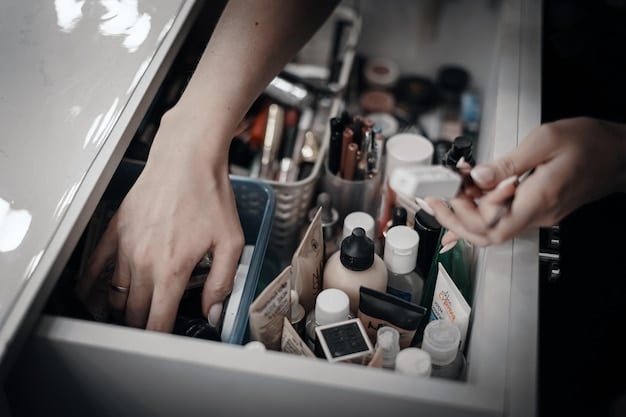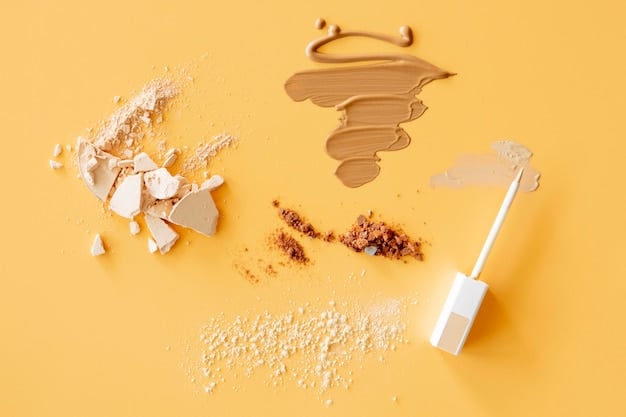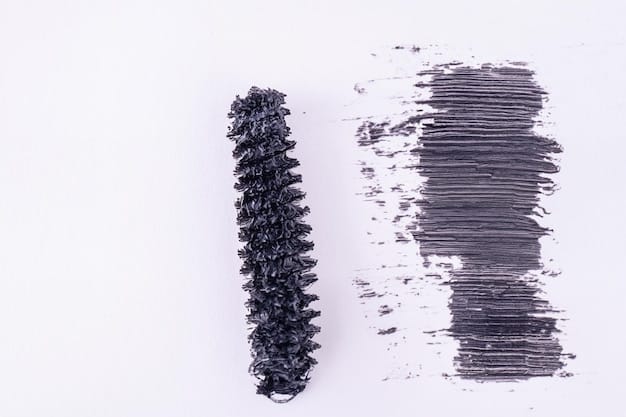Stop Wasting Money: Safely Using Expired Beauty Products

Stop wasting money by learning how to assess and safely use expired beauty products, extending their life and saving you money, while being mindful of potential risks.
Are you tempted to toss that half-used lipstick or foundation lurking in your makeup bag? Before you do, let’s talk about how to stop wasting money and explore the truth about using expired beauty products safely and effectively.
Understanding Expiration Dates on Beauty Products
Decoding expiration dates on your favorite beauty items can feel like deciphering a secret code. It’s not always as straightforward as the “use by” date on your groceries, but understanding these symbols and guidelines is crucial for both your wallet and your skin’s health.
Let’s break down what those cryptic symbols and numbers really mean and how to interpret them for different types of products.
Decoding the Symbols
Many beauty products feature a Period After Opening (PAO) symbol, which looks like a small open jar with a number followed by the letter “M” (for months). This indicates the recommended time frame to use the product after it’s been opened. For example, “12M” means the product should be used within 12 months of opening.
Another common marking is the expiration date printed as a date (e.g., EXP 10/24). This is more straightforward, indicating the product should be used before the specified date, regardless of when it was opened.
General Guidelines by Product Type
- Mascara: Typically, mascara should be replaced every 3 months due to the risk of bacterial contamination.
- Liquid Foundation: Liquid foundations usually last for 6-12 months after opening.
- Lipstick: Lipsticks can last for 1-2 years if stored properly.
- Sunscreen: Sunscreen should be replaced every year, as its effectiveness degrades over time, even if unopened.
Understanding these dates and guidelines helps you make informed decisions about when to stop wasting money on potentially harmful products and when it’s safe to continue using them.
In conclusion, paying attention to expiration dates, understanding the symbols, and following general guidelines for different product types enables you to protect your skin and wallet simultaneously. It’s about making smart choices based on informed knowledge.
Identifying Signs of Spoilage: Beyond the Expiration Date
Even before the expiration date arrives, your beauty products might show clear signs of spoilage. Relying solely on the expiration date isn’t enough; you need to be observant and aware of changes in texture, smell, and appearance.
Recognizing these telltale signs can prevent potential skin irritations or infections.
Changes in Texture and Consistency
One of the first indicators of a product going bad is a change in its texture. For example, a cream that was once smooth and easily spreadable may become thick, clumpy, or separated. Similarly, a liquid foundation might become watery or develop a grainy consistency.
These textural changes often indicate that the product’s formulation is breaking down or that it has been contaminated with bacteria or fungi.
Unusual Odors or Discoloration
Another red flag is any unusual odor. Most beauty products have a characteristic scent, but if you notice a sour, rancid, or otherwise off-putting smell, it’s a strong sign that the product has spoiled. Discoloration, such as a cream turning yellow or a foundation becoming darker, is also a sign of degradation.
These changes can be due to oxidation, bacterial growth, or other chemical reactions occurring within the product.

By staying vigilant and observing these signs, you can make a more informed choice about whether to continue using a product or to stop wasting money and dispose of it properly.
In summary, identifying signs of spoilage in your beauty products goes beyond just checking the expiration date. Paying attention to changes in texture, odor, and appearance helps you avoid potential skin issues and ensures you’re using products that are still safe and effective.
Sanitizing and Repurposing: Extending the Life of Your Products
Sometimes, a beauty product isn’t entirely spoiled but might just need a little help. Sanitizing and repurposing are great ways to extend the life of your favorite items, helping you stop wasting money and get the most out of your investment.
However, it’s crucial to know which products can be safely revived and how to do it properly.
Safe Sanitizing Techniques
For products like lipsticks and powder-based cosmetics, sanitizing can often restore them to a usable state. For lipsticks, gently wipe the surface with a clean tissue or sanitize with a spray of rubbing alcohol. Allow it to air dry completely before using.
Powder-based products like eyeshadows or blushes can be sanitized by spraying them with rubbing alcohol and allowing them to dry. This helps kill surface bacteria and prevent breakouts.
Creative Repurposing Ideas
- Eyeshadow as Eyeliner: If an eyeshadow is past its prime but still has some pigment, try using it as an eyeliner by applying it with a damp angled brush.
- Lipstick as Cream Blush: Old lipsticks can be repurposed as cream blushes. Just dab a small amount onto your cheeks and blend well.
- Mascara Wand for Eyebrow Grooming: Cleaned mascara wands can be used to groom and shape eyebrows or to separate lashes after applying mascara.
However, remember that some products, like liquid eyeliners and mascaras, are best discarded once they reach their expiration date due to the high risk of bacterial contamination. With the right precautions and creative thinking, you can extend the life of many beauty products, saving money and reducing waste, but always prioritize safety and hygiene.
In essence, sanitizing and repurposing beauty products can be a savvy and eco-friendly approach to your beauty routine, provided you know the limits and prioritize hygiene. These techniques allow you to stop wasting money by maximizing the lifespan of your cosmetics while staying safe.
Products You Should Never Use Expired
While some beauty products can be salvaged or repurposed, there are others that should be strictly avoided once they’ve passed their expiration date. These products pose a higher risk of causing infections, irritations, or other adverse effects.
Knowing which products to discard without hesitation is crucial for protecting your health.
High-Risk Products to Avoid
Certain types of beauty products create the perfect environment for bacterial growth once they are expired. Among these are products that are used close to the eyes, like mascara, eyeliners, and eye creams.
Since the eye area is particularly sensitive, using expired products can lead to infections, such as conjunctivitis or styes. Another high-risk category includes products that are applied to broken skin, such as acne treatments or wound-healing creams. Expired products can contain harmful bacteria that can lead to more serious infections when applied to open wounds.

Why These Products Are Dangerous
- Mascara and Eyeliner: These products come into close contact with the eyes, making them breeding grounds for bacteria.
- Sunscreen: Expired sunscreen loses its effectiveness, leaving your skin vulnerable to sun damage.
- Acne Treatments: The active ingredients in expired acne treatments may degrade, reducing their ability to fight acne.
Therefore, when it comes to certain beauty products, it’s always better to err on the side of caution. Adhering to expiration dates and heeding signs of spoilage will protect your skin and overall well-being as well as give you peace of mind knowing you are making the right choice for your body and wallet. The goal is to stop wasting money but never at the expense of your health.
In conclusion, there are specific beauty products that should never be used past their expiration date due to the heightened risk of infections and other adverse reactions. Prioritizing safety by knowing which products to discard and when will keep your skin healthy and protected.
Storage Tips to Prolong the Life of Your Beauty Products
Proper storage can significantly extend the life of your beauty products and help you stop wasting money. Factors like temperature, light, and humidity can affect the stability and effectiveness of cosmetics.
By following a few simple guidelines, you can keep your products fresh and usable for longer.
Ideal Storage Conditions
Most beauty products should be stored in a cool, dark, and dry place. Avoid storing them in the bathroom, where humidity and temperature fluctuations can accelerate their degradation. Direct sunlight can also break down ingredients and alter the color and texture of products.
A dresser drawer or a cool closet are often better storage options. Additionally, keep lids tightly closed to prevent air exposure, which can cause oxidation and contamination.
Specific Product Storage Recommendations
- Lipstick: Store lipsticks in a cool place to prevent them from melting.
- Nail Polish: Keep nail polish bottles tightly closed and store them upright to prevent the solvents from evaporating.
- Skincare Products: Active ingredients like Vitamin C lose efficacy if exposed to light. Keep in dark, air-tight containers.
Proper storage can make a big difference in the longevity of your beauty products. By keeping them in the right conditions, you can ensure they remain effective and safe to use, helping you get the most for your money.
In summary, storing beauty products properly is key to prolonging their life and maintaining their quality. Paying attention to temperature, light, and humidity, along with following specific storage tips for different types of products, can help you stop wasting money and enjoy your cosmetics for longer.
The Environmental Impact of Expired Products
Discarding expired beauty products doesn’t just affect your wallet; it also has environmental consequences. Many cosmetics contain chemicals and packaging materials that can harm the environment when not disposed of properly.
Understanding the environmental impact can motivate you to make more sustainable choices.
Proper Disposal Methods
Many traditional waste disposal methods don’t adequately handle the chemicals and materials found in beauty products. Improperly discarded cosmetics can leach harmful substances into the soil and water supply. Check your local regulations to see what your options are.
Some companies also offer take-back programs where you can return empty or expired products for recycling or safe disposal.
Eco-Friendly Alternatives
- Choose Sustainable Brands: Support companies that use eco-friendly packaging and sustainable ingredients.
- Buy Only What You Need: Avoid impulse purchases and buy only the products you know you’ll use.
- Reduce Packaging Waste: Look for products with minimal packaging or packaging made from recycled materials.
By being mindful of the environmental impact and adopting sustainable practices, you can reduce your ecological footprint. This not only helps protect the planet but also encourages a more responsible approach to beauty consumption, with the goal of stop wasting money and protecting the environment.
In closing, the environmental impact of expired beauty products is a significant concern that calls for responsible disposal methods and sustainable consumption habits. By choosing eco-friendly alternatives and supporting sustainable brands, we can reduce our ecological footprint and contribute to a healthier planet.
| Key Point | Brief Description |
|---|---|
| 🗓️ Check Expiration Dates | Always check expiration dates on products to ensure safety and efficacy. |
| 👃 Monitor for Spoilage | Look for changes in texture, smell, and color as signs of spoilage. |
| ♻️ Repurpose Safely | Repurpose products like eyeshadow as eyeliner if they’re still usable. |
| 🗑️ Discard Risky Items | Always discard mascara, eyeliner, and sunscreen after expiration. |
Frequently Asked Questions
▼
Yes, if it looks, smells, and feels normal. Sanitize it by wiping the surface with a tissue and rubbing alcohol. Be cautious and discontinue use if any irritation occurs.
▼
Look for changes in texture, like separation or thickening, or an off smell. If it changes in consistency or causes skin irritation, dispose of it.
▼
No, expired sunscreen loses its effectiveness and may not protect you from harmful UV rays. It is essential to replace it annually to ensure adequate protection.
▼
Store them in a cool, dry, and dark place, away from direct sunlight and humidity. Ensure lids are tightly closed to prevent air exposure and contamination.
▼
Mascara should be replaced every three months to avoid bacterial buildup, which can cause eye infections. This is crucial for maintaining eye health and hygiene.
Conclusion
By understanding expiration dates, identifying signs of spoilage, and practicing safe storage and disposal methods, you can make the most of your beauty products while protecting your health and the environment. Learning how to stop wasting money and becoming savvy about your cosmetics is a win-win for everyone!





